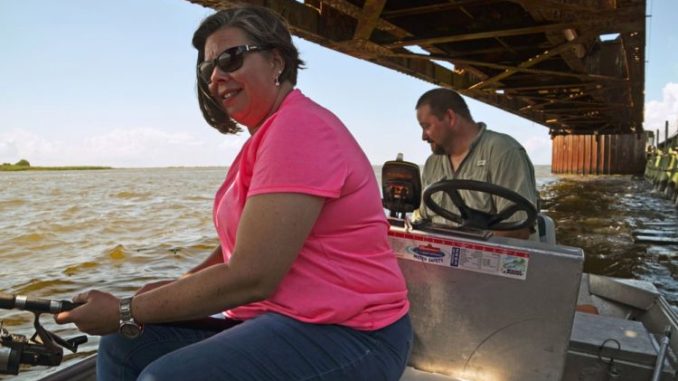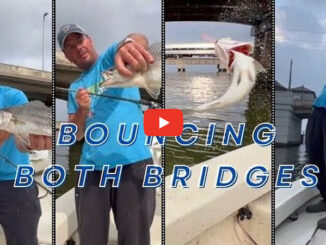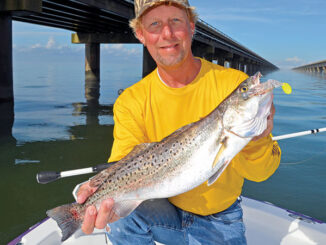
Stifling summer heat can sap the energy of any angler. Find out how this couple uses bridges near Lake Pontchartrain to stay cool while they catch.
“I like fish that pull hard, ones that fight. I’m fishin’ for fun,” twanged Jeb Ard in a patented country accent. “If I want to eat fish, we go to a catfish buffet.”
By “we,” he was referring to his wife and regular fishing partner Tina, as well as himself.
Jeb, a self-employed refrigeration repairman, and Tina, a manager/instructor for a nonprofit job training program, have perfected the art of catching fish for pure relaxation — not for food, and not to catch more than the other guy.
Their targets are redfish and black drum, and the bigger the better. And their hunting grounds are limited to five bridges that span the passes and bayous near the eastern end of Lake Pontchartrain.
They are the CSX (L & N) Bridge over Rigolets Pass, the Little Rigolets (Blind Rigolets) Pass Bridge, the Miller Bayou (Miller’s Ditch) Bridge, Unknown Pass Bridge and the U.S. Highway 90 Bridge over Rigolets Pass. The first four are train bridges, and the fifth one is for vehicular use.
The couple claims that fishing at the bridges is good year round, but they do most of their fishing during the hottest months of the summer — a surprising revelation considering that Jeb is a self-professed night owl with a strong aversion to sun exposure.
But it fits their schedule. “I hunt in the winter,” said Jeb. “And I don’t like fishing in the cold,” said Tina emphatically.
Their solution is to fish directly under the bridges, always parking their boat where the bridge spans provide deliciously cool shade.
Fishing with the couple is relaxing from the get-go: They didn’t launch their boat until 9:40 a.m.
“That early stuff don’t mean anything,” growled Jeb. “I fish by the tides and I focus on high tide. The best fishing is from three hours before high tide to three hours after high tide.
“Some places you can only fish on a slack tide because you can’t get your bait to the bottom on a strong tide. Once, we tied on an 8-pound downrigger ball at the CSX Bridge. We ran out 500 yards of steel wire and never reached bottom. The current in these passes is some of the strongest tidal flows in Louisiana.
“The bottom is where the big boys are — drum and reds up to 30 and 40 pounds. They look for the deepest water under the bridges.”
The Ards move from bridge to bridge, typically starting at the CSX Bridge, in search of their prey.
Here’s Jeb’s bridge-by-bridge description of each:
CSX Bridge
This is a relatively long bridge spanning Rigolets Pass, one of the two major passes (Chef Menteur Pass is the other one) draining Lake Pontchartrain into Lake Borgne. Tidal currents may be ferocious here, even though the water is up to 60 feet deep.
The bridge is high enough to allow the largest of bay boats to anchor beneath it, but it is a swing drawbridge which allows larger vessels such as shrimp boats and tugboats to pass through it.
Jeb’s favorite spot on the bridge is next to the wooden bumpers on the eastern side of the draw opening. (This is the only spot he fishes in direct sun.) Next favorite is a 60-foot hole midway to the eastern end of the bridge from the draw.
This bridge and the Highway 90 Bridge, also spanning the Rigolets, produce the biggest fish for the Ards.
Little Rigolets Pass Bridge
This much smaller pass prongs off Lake St. Catherine and Rigolets Pass and into the Intracoastal Waterway, slightly west of the bulk of the rest of the flow of Rigolets Pass. This is a modern concrete bridge with low overhead clearance that will prevent a bay boat with a T-top from getting under it.
Drum and redfish are common at this bridge, but average smaller in size. But as Jeb noted, “A 15-pound drum is nothing to sneeze at.” Favored fishing spots are two 25- to 26-foot deep spots under the short bridge.
Miller Bayou Bridge
Miller Bayou is a short, narrow, twisting bayou about the same width as Little Rigolets Pass. It connects the southern shore of Lake St. Catherine with Unknown Pass just before its junction with the Intracoastal Waterway.
The span is the shortest of the bridges the Ards fish, and like the Little Rigolets Bridge, is too low for a boat with a T-top to squeeze under. Jeb’s favorite spot here is 32 feet deep.
Unknown Pass Bridge
This bridge, like the Little Rigolets Bridge, is a low-slung modern concrete affair. It replaced the old railroad bridge which was damaged by Hurricane Katrina. The pass is larger than Little Rigolets and Miller Bayou, but the bridge is tricky to get positioned beneath.
Water currents here hit the bridge at an angle, and the spans between its abutments are short, making it difficult to position the boat in the shade without banging into concrete.
U.S. Highway 90 Bridge
The lone auto bridge of the five that the Ards fish, the Highway 90 Bridge (sometimes called the Fort Pike Bridge), is a mile-long high rise bridge that soars to provide a 72-foot clearance allowing marine traffic to pass unhindered beneath it.
Its height and slick concrete construction provide very little for the Ard’s rig hook to latch onto. Boat-hooking and therefore fishing is essentially limited to the large concrete caissons on each side of the channel. Each of these two caissons has what Jeb calls “man ladders” ascending vertically up their sides.
After hooking to these, Jeb allows his boat to drift just far enough down-current to fish immediately behind the pilings under the caisson. While more difficult to fish than the old rickety, clanky swing bridge it replaced in 2008, Jeb targets it simply because it produces some of the largest drum and redfish he catches at any of the bridges.
“I miss the old bridge terrible,” he grumbled softly. “It had wooden pilings. Concrete is good, but wood is better.”
Bridge fishing tips
Mentally mark spots. Over the years, Jeb and Tina have fished the whole length of each bridge, but have found that some spots are consistently better than others on the same bridge. Remembering high-action spots is key to efficient fishing.
Buy a fish finder. This type of fishing doesn’t demand a big investment in electronics, but Jeb strongly recommends that newcomers purchase a simple fish finder to quickly locate the deepest spots under each bridge. The deepest spots often correspond to the best fishing spots. “Remember, this isn’t trout fishing,” he cautioned.
Make an inexpensive rig hook. It is much easier to use a metal rig hook to latch onto a bridge than to tie and untie the boat’s bow rope. Also, some bridges are too high to comfortably reach to tie off on. Jeb’s hook is simply made by using an acetylene torch to heat a metal reinforcing bar enough to bend a large hook in one end and a small loop for the rope in the other.
Bring lots of spare tackle. Jeb claims that every bridge has cables laid on the bottom beneath the span. “I don’t know what they are for, but they are there and they are snags. You know it’s a cable because you can feel a little give when you snag one. You lose a lot of tackle fishing like this, so definitely come prepared.”
Stick with market bait. Black drum and redfish love shrimp, but live shrimp or for that matter, any live bait, just isn’t necessary. Dead shrimp, often locally called “market bait,” are very effective, but should be fresh.


